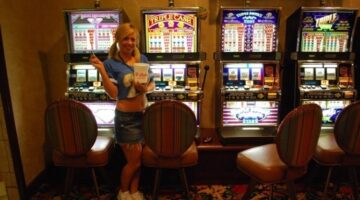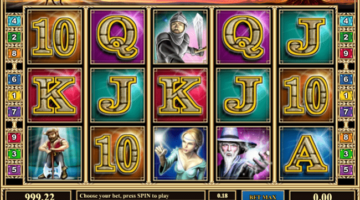HOW MECHANICAL SLOTS WORK

Most modern slot games are played on video screens, whether in brick and mortar casinos or online. But slots with mechanical reels still have a loyal following, especially in the United States with its more than a century-old tradition of three-reel games. But today’s mechanical-reel games are software-driven, just like video slots, with a few important things to understand before you play:
- Results are determined by a random number generator, which tells the reels what to display.
- Symbols are mapped onto a virtual reel.
- The frequency with which each symbol lands on a payline is not necessarily proportionate to the number of symbols on the physical reel.
- The hit frequency, or percentage of winning spins, does not necessarily correlate to the payback percentage.
- Making the maximum bet a mechanical-reel slot allows often brings you the highest payback percentage.
RANDOM NUMBER GENERATOR AND VIRTUAL REEL
For many decades after reel slot machines were invented, the number of symbols on each reel coupled with the payoff on each winner determined the game’s payback percentage.
That’s no longer the case. The random number generator and virtual reel have led to machines where the real game is being played internally, in the machine’s software. When the random numbers have been selected, the game programming tells the reels which symbols to display.
ABOUT RANDOM NUMBERS
It’s said that nothing in the universe above quantum level is truly random, but random number generators are close enough that players can’t discern any repeating patterns, and the long-term percentages are those you would expect from randomly occurring outcomes. Here are a few key points about the RNG:
- RNGs use algorithms to calculate their numbers.
- RNGs are very fast, generating dozens and sometimes hundreds of random numbers per second.
- The RNG keeps running even when the machine is not being played.
- The only function of the RNG is to generate random numbers. It doesn’t know how those numbers are used.
- The RNG works with a full set of numbers on every spin, so all results are possible on every spin.
How many random numbers are used and how they are mapped onto symbols differs from game to game. So do the entry points to start the next calculation. With more sophisticated RNGs, hitting the “Bet One Coin” button, the “Max Bet” button or pulling the handle could start the algorithm from different points. Because the RNG works so fast, if you pause slightly before your next play or stop for a few seconds to order a beverage or chat with a neighbor, your result will be different than if you kept at the same pace. That doesn’t mean your result will necessarily be better or worse, just different.
If you leave a machine and someone else takes your place and hits the jackpot, that doesn’t mean you’d have won if you’d stayed. The RNG would be at a different point in its calculations.
ABOUT THE VIRTUAL REEL
The virtual reel makes it possible to have a much larger range of outcomes than if odds were determined by the number of symbols and spaces on a mechanical reel Mechanical reels must fit inside a machine’s casing. You can increase a reel’s size from 10 symbols and 10 spaces to 20 and 20, 30 and 30 and so on up to a point, but if you want to drive odds that make a really big jackpot possible, you need more combinations than physical reels alone can handle. Mapping symbols and spaces onto a virtual reel dramatically increases the number of possible combinations.
Let’s keep the arithmetic simple, and say you have a reel with 10 symbols and 10 spaces. The symbols can be the same as the example in Chapter 2-1: Each reel has one 7, two bars, three cherries and four watermelons.
But instead, let’s map all those symbols and spaces onto a virtual reel, so there are 50 stops on each reel:
A FEW THINGS OF NOTE:
In this example, each like symbol was given the same number of stops on the virtual reel. That doesn’t have to be the case. Cherry No. 1 could be given three stops and Cherry No. 2 six stops, or any other number, if that’s what fits the desired odds of the game. Mapping does not have to be identical for each reel. Cherry No. 1 could have three random numbers on reel No. 1, four on reel No. 2 and five on reel No. 3, if that led to the desired odds. On mechanical-reel machines today, the spaces between symbols also are stops. Symbols alone were counted here to simplify the arithmetic for the same of example.
Now let’s compare what the virtual reel does to the number of combinations, compared to the physical reels alone.
With odds determined by the physical reel, the chances of lining up the rarest combination, 7-7-7, are 1 in 1,000, so the jackpot can’t be very large. Even if you keep paybacks very small on other three-symbol combinations, it would be difficult to have a top jackpot of more than a couple of hundred coins. By mapping those symbols onto this simplified virtual reel, the jackpot chances become 1 in 125,000. Now the jackpot can run into thousands of coins, and there’s a lot more room for paybacks on other symbols. Let’s use physical reels and virtual reels to make up pay tables that are identical, except with the jackpot set high enough to bring the total return to 90 percent:
Both those games have odds that would lead to a 90 percent return, but letting the number of symbols on the physical reel dictate the odds leads to a jackpot of not quite 300 coins while using the virtual reel enables jackpot of more than 25,000 coins.
Everything’s easily adjustable with so many possibilities. Game designers can give you a less volatile game by making the jackpot smaller and increase paybacks on lesser winners. There’s not the same kind of wiggle room when you’re dealing with only 1,000 possible combinations.
- combination of a random number generator and a virtual reel determine what symbols and spaces you see on a slot with mechanical reels.
- The random number generator operates continuously, even when a machine is not being played, and any change in your timing will lead to a different result.
- The virtual reel can make a physical reel behave as if it has many more symbols than it really does, and leads to more possible combinations.
- The increase in the number of combinations enables bigger jackpots and more variation in payoffs.
Las Vegas Casino Online
HIT FREQUENCY VS. PAYBACK PERCENTAGE
Winning the most often doesn’t always translate into winning the most money. There are two separate concepts:
- Hit frequency is the proportion of spins that pay money to players.
- Payback percentage is the proportion of wagers returned to players as winnings.
Let’s start by considering two games with identical pay tables, but different hit frequencies. These are not real games; it’s just an example set up to make the arithmetic that follows easy. Reel stops include blank spaces as well as symbols, but only three of the same symbol form a winning combination. Odds are set so there are 10,000 possible combinations, so what’s listed in this table are the number three-symbol possibilities per 10,000 spins:
We can tell several things from the chart above:
- Of 10,000 combinations, Game A has 1,336 winners to only 1,005 on Game A.
- The 1,336 Game B winners give it a 13.36 percent hit percentage, to 10.05 percent on Game A.
- Both the hit frequencies and paybacks per win are the same on 7s, bars and cherries.
- The 331 extra melon winners give Game B both a higher hit frequency and higher payback percentage.
Per 10,000 coins wagered, each game pays 1,000 on 7s, 3,500 on bars and 3,000 on cherries, for a total of 7,500. But Game A pays 1,338 on melons, and game B pays 2,000. That makes the total return 8,838 on Game A, giving it an 88.8 percent payback percentage. Game B has a total payback of 9,500 coins for a 95 percent payback percentage.
If these two games were sitting side-by side in the casino, they would appear to be identical. Winning combinations and their paybacks would be displayed, and those are the same. Players would not be able to tell one machine had a higher hit frequency and payback percentage.
ADJUSTING THE PAY TABLE
What if a slots game designer wanted a machine with Game A’s hit frequency, but Game B’s payback percentage, or Game B’s hit frequency but Game A’s payback percentage? One route is by adjusting the pay table.
- The hit frequencies are still 13.36 percent on Game B and 10.5 percent on Game B.
- The payback on cherries has been changed to 120 on Game A, and down from 100 to 80 on Game B.
- Game B still has a higher hit frequency.
- Game A now has a higher payback percentage.
The larger payoffs on cherries are enough to bring Game A up to a 95.38 percent payback percentage, just a fraction more than Game B paid in the first example. Game B is now down to 88 percent, a fraction less than Game A paid earlier. So here, the game with the higher hit frequency is actually the lower payer.
WHAT YOU SEE VS. WHAT YOU GET
In the above gokken example, it looks like you can tell which is the higher payer, because Game A both pays more on cherries and has a higher payback percentage. Can a glance at the pay table tell you which game is a higher payer?
The answer to that is no, a look at the pay table can be misleading. Let’s try one more example, in which one game pays more on every winning combination. Once again, we’re using an example with 10,000 possible reel combinations.
From the outside, Game A looks like a much higher payer, paying 1,500 vs. 1,000 for Game B on three 7s, 150 vs. 100 on 100 on bars, 20 vs. 10 on cherries and 2 vs. 1 on melons.
But internally, out of your view, the hit frequencies also have been changed. Game A now has a hit frequency of only 5.76 percent, while Game B has been increased to 25.31 percent.
Let’s look at what that does to the overall payback, adjusting for the number of winners for each three-symbol combo:
- Game A pays more on every winning combination but has a lower payback percentage, 90.5 percent vs. 92 percent on Game B.
- On 2,200 spins, the melons on Game B pay only the size as your bet.
- On Game A, there are only 400 melon winners, but they pay double your bet.
Such a large number of low-paying spins means Game B will have low volatility, which has the effect of extending your play.
Games with such a large difference in hit frequency but such a small difference in payback percentage were used to show you the kind of leeway game designers have. If 2,050 melon combinations were used instead of 2,200, the games would have identical payback percentages, but would be vastly different playing experiences.
In that case, you would have a better chance at winning big at Game A, but a better chance at extended playing time at Game B. Real games are more complex than these examples, but offer the same kinds of different playing experiences.
On real three-reel mechanical slot games, hit frequencies as low as 5.76 percent and as high as 25.31 percent are rare. Real three-reel, single-payline games have hit frequencies that cluster between about 9 and 13 percent. Games with more paylines have higher hit frequencies.
The examples above are to illustrate principles. Real mechanical slots and their math are more complex. Three-reel games usually have more than four symbols, opening more possibilities, and game programmers aren’t confined to using number sets that yield 10,000 combinations – in fact, on big jackpot games, the number sets are much, much larger.
Here are a few additional factors that add complexity, texture and fun to the mechanical-reel portion of modern slot floors:
- Many newer three-reel slots have more than one payline.
- Games with more than three mechanical reels have a niche in casinos, with five reels often used.
- Many three-reel games today also incorporate bonus events.
Games with multiple paylines open more possibilities and add complexity to the calculations. Three lines across the screen plus two diagonals take a game to five lines, and more lines can be created with Vs and zigzags, just like on video slots. In recent years, game manufacturers have produced three-reel mechanical games with as many as 27 paylines. Bonus events also add complexity to calculation. A diminishing number of games put all the focus omn the spinning reels. However, many three-reel games incorporate free spins, bonus wheels on top of the games, or secondary video screens to create a hybrid mechanical-video game. Any bonus payouts have to be accounted for in calculating the game’s overall return.
- Higher hit frequencies don’t always bring higher overall returns.
- A game that looks like a high-payer to a player could actually be a lower-paying game than one with a lower pay table.
- Game designers and programmers use a combination of hit frequency and payback per win to get to a final payback percentage.
- Additional factors in modern mechanical slots include multiple paylines, using five reels instead of three and incorporating bonus events into the games.
PROGRESSIVE JACKPOTS: STANDALONE, LINKED AND WIDE AREA
Walk through any sizable casino and you’ll see a slot floor lit up by clusters of machines with electronic jackpot signs on top. Penny by penny, the jackpot grows, from $12,355.67 to $12,355.68 to $12,366.69 and beyond. When somebody wins the jackpot, the total on the sign is reset to a base value, then starts building again for the next big winner.
These games with the building prizes are progressive slot machines, and they’ve been favorites of jackpot hunters for decades. The base awards can be small, as in the $250 starting point on 25-cent Blazing 7s slot machine from Bally Technologies, or can be life-changing, with jackpots of millions of dollars in $1 Megabucks machines from International Game Technology.
On games with mechanical reels, there are three basic types of progressives:
- Standalone progressives
- Linked progressives
- Wide-area progressives
Every player should know that on any of these, it almost always takes a maximum bet to be eligible for the jackpot. If you’re playing a dollar machine with a three-coin maximum bet and you wager only $2, you can’t win the progressive award.
Mechanical slots sometimes are set up with multi-tiered progressives and mystery progressives, but those are more common on video slots. They also don’t usually require a max-coins wager to win the jackpot.
You can read more about them in Chapter 6: Video Slot Progressives.
STANDALONE PROGRESSIVES
Standalones have jackpots that that build at a single machine.
- The lighted jackpot display usually is within the top portion of the top box above the main reels.
- A portion of each bet players make at that machine is added to the jackpot.
- After a player wins the jackpot, it is reset to the base value to start building again.
- Standalone progressive machines usually are in a bank with several machines of the same type.
- Each machine has its own jackpot, so, each machine will display a different jackpot amount.
LINKED PROGRESSIVES
Linked progressives electronically link the jackpots at a number of machines in the same casino.
- The same jackpot is available to players at any machine in the link.
- A portion of each bet players make at any of the linked machines is added to the jackpot.
- After a player wins the jackpot, it is reset to the base value for all machines in the link.
- Machines in different parts of the casino can be on the same link.
- All machines on a progressive link will display the same jackpot.
Sometimes there will be a large lighted sign over the top boxes of several machines in the bank, displaying the jackpot award. Such a display ties the machines together visually, emphasizing that all have the same jackpot. Then ability to link games in different parts of the casino can sometimes confuse players. I was once in a riverboat casino in the State of Illinois, playing in the downstairs level, when the jackpot reset on a bank of IGT Double Diamond machines. No one at the bank had won the jackpot, and players were baffled. It turned out someone had one upstairs, on another Double Diamond bank on the same link.
WIDE-AREA PROGRESSIVES
Wide-areas are linked progressives on a bigger scale. They link jackpots at machines at different casinos. The biggest jackpots in a casino almost always are wide-area progressives. GT launched Megabucks as the first wide-area system in 1986, and IGT remains by far the biggest provider of wide-area progressives with links including Wheel of Fortune and TV Hits (with game themes based on television shows).
- Often, a big, bright jackpot stretches above several machines. Displays attract attention from all over the casino.
- The same jackpot is available to players at any machine on the link, even if at different casinos.
- The jackpot starts at a base value, then a portion of each bet players make on any machine in the link is added.
- When a player wins the jackpot, the jackpot is reset to a base value at multiple casinos
- All machines on the link display the same jackpot.
When the jackpot display resets on a linked progressive, players know someone, somewhere has struck it rich. The winner might be hundreds of miles away, but you know from the reset that there’s been a big hit. That jackpot is built by players who can be hundreds of miles apart. On the IGT’s Megabucks Nevada link, a wager made in Reno contributes to the jackpot building in Las Vegas, Lake Tahoe or anywhere else in the state.
PROGRESSIVE PROS AND CONS
Should you play a progressive slot machine?
The jackpots are the attraction.
They draw in players who are looking for the chance at a win that can change their lives.
Games with smaller base jackpots usually pay more often than bigger jackpot games.
The chance of winning the top prize at Megabucks is about 1 in 50 million. Megabucks goes years at a time between jackpot payouts. On the other hand, Bally’s Blazing 7s, with a base prize of $1,000 on a $1 machine, was designed as a rapid hit game. If there are 10 to 20 machines in a casino, someone will hit the jackpot an average of once every 15 minutes to half an hour. It’s up to you: Do you want
to take a long shot at millions, or have a better chance at a much more modest prize?
A larger portion of the overall payback is tied up in the top jackpot than in non-progressive games.
That means progressive machines usually give less back to players in smaller wins, whether through reductions in the pay table or a reduced hit frequency. The chance at a big jackpot is a tradeoff for an increased risk of a rapid bankroll drain.
It’s important to read the machine glass and understand the conditions of the game before you play.
On three-reel mechanical games, it almost always takes a max-coins bet to be eligible for the progressive. If you don’t bet the max, some games will pay you a reduced amount if you line up the jackpot symbols. But on some, called “buy-a-pays” in the slot industry, each coin activates a set of symbols. On a three-coin Blazing 7s game, for example, the jackpot 7s are not winning symbols unless you bet the third coin.
Bottom line:
Jackpot hunting can be fun and sometimes rewarding, but if your bankroll won’t stretch to betting enough to be eligible for the progressive award, you’re better off at a non-progressive machine.
- Progressive slot machines build jackpots by taking a portion of each wager and adding it to the jackpot until somebody wins.
- Standalone progressives build at individual games; linked progressives build a jackpot shared by a number of machines within a casino; and wide-area progressives link the jackpot at machines in different casinos.
- It almost always takes a maximum-coins bet to be eligible for a progressive jackpot on a machine with mechanical reels, and if you’re not prepared to bet max coins, you should play a non-progressive machine.
TEST YOURSELF
- What determines the combinations of symbols you see on the reels of a mechanical-reel game?
- How can slot programmers and designers make a reel behave as through it has more symbols and spaces than it really does?
- True or False: Increasing the number of possible reel combinations enables gamemakers to design slots that offer bigger jackpots and more variation in pay tables.
- What is the percentage of spins that win for the player called?
- Do slot machines with high hit frequencies have higher payback percentages than those with lower hit frequencies?
- True or False: All three-reel slots have just one payline, as opposed to as many as 100 paylines on video slots.
- Can you tell by looking at two machines which is the higher payer?
- How do progressive slot machines build big jackpots?
- What is the difference between standalone, linked and wide-area progressives?
- When should you bet maximum coins if you play a buy-a-pay slot?
Answers
- The combinations of symbols you see on a three-reel game are determined by a random number generator and virtual reel.
- Slot programmers and designers make a reel behave as through it has more symbols and spaces than it really does by mapping the symbols to a virtual reel.
- True. Increasing the number of possible reel combinations enables gamemakers to design slots that offer bigger jackpots and more variation in pay tables.
- The percentage of spins that win for the player is called the hit frequency.
- No, machines with high hit frequencies do not necessarily have higher payback percentages than those with lower hit frequencies. The overall payback can be higher, lower or the same with a higher hit frequency.
- False. Not all three-reel slots have just one payline.
That’s a common configuration, but some has as many as 27 paylines. - No, you can’t tell by looking at two machines which is the higher payer. They can look identical, but don’t necessarily have identical hit frequencies or payback percentages.
- Progressive slot machines build big jackpots by adding a percentage of each bet to the jackpot until somebody wins.
- Standalone progressives build the jackpot from bets at a single machine, linked progressives build a jackpot from bets on a number of electronically linked machines and wide-area progressives build jackpots from bets on machines linked at more than one casino.
- If you play a buy-a-pay slot, you should bet the max when big-paying symbols become non-paying symbols without a max-coins wager.
Relevant news

Roaring 21 Casino Review
See the best cryptocurrency casinos Roaring 21 Casino Overview: Roaring 21 comes from probably THE…

Detroit casinos set all-time gaming revenue record in March
Detroit casinos set all-time gaming revenue record in March BY Peter Amsel ON April 13,…

Slot Machine Tips – The Basics
SLOT MACHINE BASICS You are reading this guide because you want to learn how slot…

SLOTS BONUS EVENTS
Bonus features are where much of the creative, interactive fun of slot machines is focused.…

888 Tiger Casino Review
The best just got better, 888Tiger Casino used to have a great reputation but they…

Roaring 21 Casino Review
See the best cryptocurrency casinos Roaring 21 Casino Overview: Roaring 21 comes from probably THE…

Detroit casinos set all-time gaming revenue record in March
Detroit casinos set all-time gaming revenue record in March BY Peter Amsel ON April 13,…

Slot Machine Tips – The Basics
SLOT MACHINE BASICS You are reading this guide because you want to learn how slot…

SLOTS BONUS EVENTS
Bonus features are where much of the creative, interactive fun of slot machines is focused.…

888 Tiger Casino Review
The best just got better, 888Tiger Casino used to have a great reputation but they…

